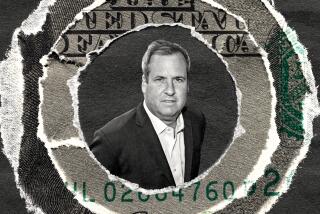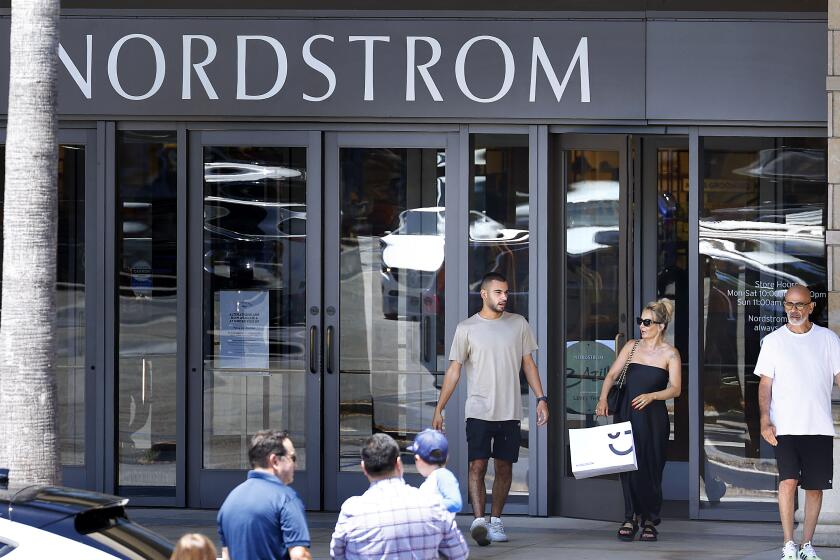Villain or vilified?
- Share via
When David Gautreaux volunteered to assist at a charity golf tournament in Thousand Oaks two years ago, he was eager to meet the event’s host, Angelo R. Mozilo, then chief executive of mortgage giant Countrywide Financial Corp.
An actor and investor who owned Countrywide stock, Gautreaux was stationed at the 12th hole when Mozilo strode onto the green. Gautreaux remarked that Mozilo was winning.
“He turned at me, and his voice was like a bark. He said, ‘We better be!’ ” recalled Gautreaux, who was taken aback. “A charity pro-am is the last place you’d feel compelled to do that -- especially as the host. The host should be the person who wants everybody else to have a great time.”
Brash and ultra-competitive, the 70-year-old Mozilo has chafed more than a few people with his drive for dominance since he co-founded Countrywide in 1969. Now, more than a year after the company’s near-collapse and humbling takeover by Bank of America Corp., the Bronx native is preparing to defend himself against a civil suit by federal regulators alleging fraud and insider trading.
From a broader perspective, Mozilo is also awaiting the verdict of history: Was he the No. 1 culprit of the financial crisis, as some (including Time magazine) have suggested? Or was he merely an aggressive executive who made mistakes while trying to keep his “baby,” as he called Countrywide, atop the heap?
“Mozilo’s fingerprints are all over the economic catastrophe we are living. He was the Typhoid Mary of the mortgage business, spreading the exotic-loan disease far and wide,” said Dan Pedrotty, director of the AFL-CIO’s office of investments. “He was also grossly overpaid, especially considering the fact that he drove his company off a cliff.”
Others are more charitable, saying Mozilo’s conduct was no worse than that of the industry as a whole.
“By mortgage industry standards, Angelo was a straight shooter,” said Guy Cecala, editor of trade publication Inside Mortgage Finance. “Did the company get so large that he couldn’t have hands-on oversight of everything, and things got out of control? I think that’s what happened.”
Regulators have weighed in, and not favorably. Lawsuits in several states, including California, contend Mozilo allowed Countrywide to lure borrowers into unaffordable adjustable-rate loans.
The fraud and insider-trading suit filed by the Securities and Exchange Commission alleges Mozilo and his top lieutenants publicly assured investors that all was well while converting Countrywide into a mill for subprime and exotic loans that he denounced in internal e-mails as “toxic” -- and while changing his personal trading plans to unload more Countrywide shares.
There are private lawsuits as well, by the score, and a federal criminal probe to boot.
Mozilo’s lawyers have denied any wrongdoing by their client, calling the SEC lawsuit politically motivated and saying the e-mails were taken out of context. But the swirling allegations have forced Mozilo, who at one point was on a Barron’s magazine list of most-respected CEOs, into a defensive crouch.
Once a common sight on CBNC being interviewed by anchor Maria Bartiromo, with his gold cuff links and hand-tailored shirts and suits, Mozilo has adopted such a low profile that acquaintances, analysts and members of the public report “Angelo” sightings like fans spotting a movie star, or informants a fugitive: Mozilo in restaurants in Montecito, Calif., where he owns a compound; Mozilo playing cards, seemingly untroubled by all the accusations, in La Quinta, where he has a home at a golf resort.
He didn’t respond to calls seeking comment for this article, and his attorney, David Siegel, didn’t respond to requests to discuss Mozilo’s defense or current activities. Close friends and family members have also declined to speak on the record.
Reached by phone at home by a Times reporter several months ago, he accused the newspaper of distorted coverage of him and of Countrywide. (The SEC lawsuit followed a Times article detailing how, as the mortgage market swooned in late 2006 and 2007, Mozilo had cashed in $138 million in stock options.) “Why should I talk to you?” he demanded before hanging up.
The self-made mortgage mogul’s early history has been told frequently, often by Mozilo himself: his mother’s motivating him to go to Fordham University instead of cutting meat in his immigrant father’s shop; the foot in the door as a 14-year-old messenger for a New York mortgage firm; the ostracism a dark-skinned Italian American endured while working an early mortgage job in the South; the perceived slights by Ivy Leaguers at white-shoe Wall Street firms.
“At least in my generation, when you are Italian in the financial services company you are terribly underestimated,” Mozilo told a doctoral candidate at Gonzaga University, a Jesuit school in Spokane, Wash., attended by at least three of his five children and where Mozilo has served as a trustee.
“A natural reaction for some in the financial community inferred or suggested that perhaps you were associated with the Mafia,” Mozilo told Howard Edward Haller, whose dissertation profiles leaders who overcame adversity.
Perhaps such adversity made Mozilo more sympathetic to all victimized groups.
“Angelo has always championed equal rights for all: blacks, whites, gays, women, immigrants,” Lori Mozilo, a younger sister, wrote in July 2008 in a Huffington Post essay titled “Vilified: What You Don’t Know About My Brother, Angelo Mozilo.” Her brother, she said, “has spent a lifetime trying to bring the dream of homeownership within reach of all Americans . . . which required the loosening of credit standards to include people who have historically been denied affordable loans.”
Even after acquiring tremendous wealth, Mozilo never stopped selling. Former Countrywide loan officers offer stories about “friends of Angelo” loans, most of them made through a Countrywide unit that offered smooth service and favorable terms to those who crossed paths with Mozilo and other Countrywide honchos. Such “friends” included not only celebrities and politicians but also everyday folks.
The CEO was always happy to hand out his business cards and tell people he would personally get them a great deal.
“I could always tell where he had been,” said Robert Feinberg, one of the loan officers who handled the VIP mortgages. “If he was playing Pebble Beach, I’d get a call from a caddie the next day. If he was in the hospital, it would be nurses.”
Perhaps the ultimate victory in Mozilo’s battle for acceptance came when Countrywide became the largest U.S. mortgage lender. The company moved into the No. 1 slot, first in 1992 when it was a writer of loans backed by Ginnie Mae, Fannie Mae and other government-sponsored entities, and again in 2004, when Countrywide recaptured the lead over Washington Mutual Inc. and Wells Fargo & Co.
Countrywide reemerged on top in part by aggressively purchasing mortgages originated by other lenders, said Paul Muolo, executive editor of National Mortgage News.
But 2004 also marked the start of the lender’s all-out embrace of the industry’s plunge into risk: subprime loans for borrowers with bad credit, “piggyback” second mortgages that allowed borrowers to buy homes without down payments, loans made without verifying income, and mortgages allowing payments that didn’t even cover the interest coming due each month, so that the mortgage balance would rise instead of fall.
As the bubble inflated, competition intensified and lending standards grew ever more lax, Mozilo denounced what he characterized as competitors’ recklessness but said his firm would continue to compete with them and put them out of business. “I’ve been doing this for 53 years, and I’ve never seen that situation sustained,” Mozilo said during a February 2006 conference call, condemning as “irresponsible” his subprime rivals, New Century Financial Corp. and Ameriquest Mortgage Co. “Eventually they gag on it.”
Although it lasted longer than the pure subprime companies, Countrywide nearly followed them into oblivion before BofA tossed out its $4-billion takeover lifeline last year.
“You have to make a choice -- to get out or not. And they stayed,” said Cecala of Inside Mortgage Finance. “It’s hard when you’re following someone off a cliff to know when to stop.”
For much of Countrywide’s history, others near the top of the corporate hierarchy were more likely to have known when to stop -- and to have reined in the company before it went over the edge, said business consultant Eric Flamholtz, a professor emeritus at UCLA Anderson School of Management who began assisting Countrywide with its strategic planning in the late 1990s.
Countrywide co-founder David Loeb, whom Mozilo often described as a mentor, had played that role, serving as strategist and financial expert -- Flamholtz called him a “strategic visionary” -- while Mozilo oversaw operations.
Loeb, a former home builder 15 years Mozilo’s senior, retired as Countrywide’s chairman and president in 2000 and died in 2003.
Flamholtz said the role of occasional brakeman was assumed for most of this decade by former Countrywide President Stanford Kurland, who was being groomed to succeed Mozilo but left in late 2006 when Mozilo opted not to take a planned retirement.
Kurland, who had overseen the company’s diversification into banking and insurance, was replaced as Mozilo’s No. 2 by David Sambol, who had run Countrywide’s lending operations. The SEC complaint describes Sambol as the chief proponent of much of Countrywide’s risky lending. He has denied misleading borrowers or investors. Sambol and Mozilo left the company after the BofA takeover in 2008.
“Stan kept Sambol in check,” Flamholtz said. But the company leadership became unbalanced when Kurland quit and Mozilo stayed on, he said.
“Angelo was the most charismatic leader I have ever seen,” Flamholtz said. “If he had left as planned he would have gone out in a blaze of glory, but ego and ambition got in the way.”
--
--
(BEGIN TEXT OF INFOBOX)
Countrywide’s rise and fall
1969: Countrywide is founded by Angelo R. Mozilo and David Loeb.
1985: The company’s shares begin trading on the New York Stock Exchange.
1992: The firm becomes the largest U.S. mortgage lender. But it loses that ranking three years later.
2004: Countrywide ramps up production of subprime and other risky mortgages. It reclaims the title as No. 1 home lender.
2005: The firm posts net income of $2.5 billion for the year. Mozilo takes home $160 million in pay, including profits taken on stock options.
2006: Mozilo files a plan in October to sell 350,000 shares a month of his Countrywide stock and a separate plan in December to sell 115,000 shares a month.
February 2007: He doubles the number of shares to be sold under the second plan.
October 2007: Countrywide posts a $1.2-billion third-quarter loss. It incorrectly predicts profits will return.
January 2008: Facing threat of collapse, the firm accepts a takeover by Bank of America, which is completed that July for stock worth $2.5 billion.
June 2009: The Securities and Exchange Commission sues Mozilo, accusing him of fraud and insider trading.
More to Read
Inside the business of entertainment
The Wide Shot brings you news, analysis and insights on everything from streaming wars to production — and what it all means for the future.
You may occasionally receive promotional content from the Los Angeles Times.











